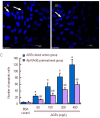Injury of cortical neurons is caused by the advanced glycation end products-mediated pathway
- PMID: 25206382
- PMCID: PMC4145921
- DOI: 10.3969/j.issn.1673-5374.2013.10.005
Injury of cortical neurons is caused by the advanced glycation end products-mediated pathway
Abstract
Advanced glycation end products lead to cell apoptosis, and cause cell death by increasing endoplasmic reticulum stress. Advanced glycation end products alone may also directly cause damage to tissues and cells, but the precise mechanism remains unknown. This study used primary cultures of rat cerebral cortex neurons, and treated cells with different concentrations of glycation end products (50, 100, 200, 400 mg/L), and with an antibody for the receptor of advanced glycation end products before and after treatment with advanced glycation end products. The results showed that with increasing concentrations of glycation end products, free radical content increased in neurons, and the number of apoptotic cells increased in a dose-dependent manner. Before and after treatment of advanced glycation end products, the addition of the antibody against advanced glycation end-products markedly reduced hydroxyl free radicals, malondialdehyde levels, and inhibited cell apoptosis. This result indicated that the antibody for receptor of advanced glycation end-products in neurons from the rat cerebral cortex can reduce glycation end product-induced oxidative stress damage by suppressing glycation end product receptors. Overall, our study confirms that the advanced glycation end products-advanced glycation end products receptor pathway may be the main signaling pathway leading to neuronal damage.
Keywords: advanced glycation end products; advanced glycation end products receptor; antibody; apoptosis; brain injury; cortical neurons; neural regeneration; neuroregeneration; oxidative stress; oxidative stress injury; pathway.
Conflict of interest statement
Figures






Similar articles
-
Inhibiting receptor for advanced glycation end product (AGE) and oxidative stress involved in the protective effect mediated by glucagon-like peptide-1 receptor on AGE induced neuronal apoptosis.Neurosci Lett. 2016 Jan 26;612:193-198. doi: 10.1016/j.neulet.2015.12.007. Epub 2015 Dec 8. Neurosci Lett. 2016. PMID: 26679229
-
[Detection of carbonyl stress markers in the urine of diabetic patients].Orv Hetil. 1999 Aug 15;140(33):1841-5. Orv Hetil. 1999. PMID: 10489784 Hungarian.
-
Sulforaphane inhibits advanced glycation end product-induced pericyte damage by reducing expression of receptor for advanced glycation end products.Nutr Res. 2014 Sep;34(9):807-13. doi: 10.1016/j.nutres.2014.08.010. Epub 2014 Aug 29. Nutr Res. 2014. PMID: 25241332
-
Advanced glycation end-products: modifiable environmental factors profoundly mediate insulin resistance.J Clin Biochem Nutr. 2015 Jul;57(1):1-12. doi: 10.3164/jcbn.15-3. Epub 2015 Jul 1. J Clin Biochem Nutr. 2015. PMID: 26236094 Free PMC article. Review.
-
Role of advanced glycation end products in cellular signaling.Redox Biol. 2014 Jan 9;2:411-29. doi: 10.1016/j.redox.2013.12.016. eCollection 2014. Redox Biol. 2014. PMID: 24624331 Free PMC article. Review.
Cited by
-
Fundamental differences in patterns of retinal ageing between primates and mice.Sci Rep. 2019 Aug 29;9(1):12574. doi: 10.1038/s41598-019-49121-0. Sci Rep. 2019. PMID: 31467395 Free PMC article.
-
Dietary galactose exacerbates autoimmune neuroinflammation via advanced glycation end product-mediated neurodegeneration.Front Immunol. 2024 Aug 9;15:1367819. doi: 10.3389/fimmu.2024.1367819. eCollection 2024. Front Immunol. 2024. PMID: 39185426 Free PMC article.
-
Icariin Inhibits AGE-Induced Injury in PC12 Cells by Directly Targeting Apoptosis Regulator Bax.Oxid Med Cell Longev. 2019 Apr 22;2019:7940808. doi: 10.1155/2019/7940808. eCollection 2019. Oxid Med Cell Longev. 2019. PMID: 31178973 Free PMC article.
-
Targeting Inflammatory-Mitochondrial Response in Major Depression: Current Evidence and Further Challenges.Oxid Med Cell Longev. 2020 Apr 14;2020:2972968. doi: 10.1155/2020/2972968. eCollection 2020. Oxid Med Cell Longev. 2020. PMID: 32351669 Free PMC article. Review.
-
Reactive Oxygen Species-Mediated Damage of Retinal Neurons: Drug Development Targets for Therapies of Chronic Neurodegeneration of the Retina.Int J Mol Sci. 2018 Oct 27;19(11):3362. doi: 10.3390/ijms19113362. Int J Mol Sci. 2018. PMID: 30373222 Free PMC article. Review.
References
-
- Rees MD, Kennett EC, Whitelock JM, et al. Oxidative damage to extracellular matrix and its role in human pathologies. Free Radic Biol Med. 2008;44(12):1973–2001. - PubMed
-
- Alikhani Z, Alikhani M, Boyd C, et al. Advanced glycation endproducts enhance expression of pro-apoptotic genes and stimulate fibroblast apoptosis through cytoplasmic and mitochondrial pathways. J Biol Chem. 2005;280(13):12087–12095. - PubMed
-
- Wang T, Fu F, Han B, et al. Danshensu ameliorates the cognitive decline in streptozotocin-induced diabetic mice by attenuating advanced glycation end product-mediated neuroinflammation. J Neuroimmunol. 2012;45(1-2):79–86. - PubMed
-
- Nitti M, Furfaro AL, Traverso N, et al. PKC delta and NADPH oxidase in AGE-induced neuronal death. Neurosci Lett. 2007;416(3):261–265. - PubMed
LinkOut - more resources
Full Text Sources
